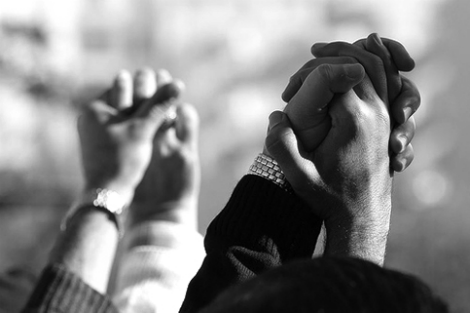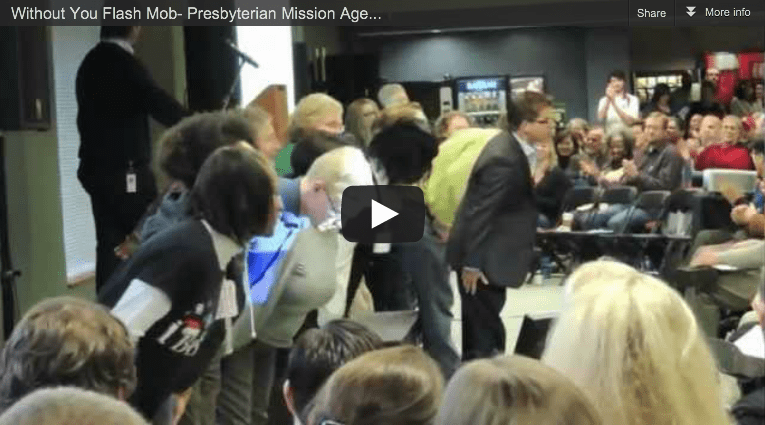 View and Print as PDF.
View and Print as PDF.

A generation ago, J.B. Phillips famously wrote a book that warned, “Your God is Too Small.” In an environmental age, it has become clear that, if Phillips’ indictment is correct, it may be because the Gospel we share has been condensed and packaged almost beyond recognition in our consumer age.
Evangelical scholar Scot McKnight suggests “the Reformation, for all its good, has led to a ‘salvation’ culture instead of a ‘gospel’ culture” and that “the near-reduction of ‘gospel’ to ‘personal salvation’ is at the heart of this problem.”[1]
One classic example of this kind of “Good News in a can” is “The Four Spiritual Laws” developed by Bill Bright and Campus Crusade for Christ in the latter-half of the 20th century. In their original form, they read:
- Law 1: God loves you and offers a wonderful Plan for your life.
- Law 2: Man is sinful and separated from God. Therefore, he cannot know and experience God’s love and plan for his life.
- Law 3: Jesus Christ is God’s only provision for man’s sin. Through Him you can know and experience God’s love and plan for your life.
- Law 4: We must individually receive Jesus Christ as Savior and Lord; then we can know and experience God’s love and plan for our lives.
These “laws,” with the four easy, how-to steps that emphasize the individual and demand a response to the inherent sales pitch, worked remarkably well in the U.S. culture in the late modern era with its own emphasis on individualism and pre-packaged, fast-food consumerism. Yet “Mark Noll once said [the Laws] led to an evangelical environment that is ‘naive, inept or tendentious.’ Columbia University religion professor Randall Balmer contends that the Laws ‘flatten the Gospel’.”[2]
Here in what many sages point to as the post-modern, global era, with a growing awareness of the world’s dwindling resources, booming population, and looming climate change, it is time to re-contextualize the Good News for our age.
How might those among us who continue to identify in some sense as Evangelicals reimagine the Gospel for our times? We can reach out and we can reach back, hearing long-neglected voices from both historic and global expressions of our faith.
As Sarah McFarland Taylor notes, “Making [the] shift from being… ‘dominators of creation’ to ‘participants in a cosmic story’”[3] is never easy. Willis Jenkins of Yale Divinity School though offers hope as he points to a way forward with a renewed purpose: “to demonstrate practical possibilities resident in ancient traditions.”[4] It is on these ancient stone paths that we may find our way home.
And here, in this article, I hope, not to provide an exhaustive examination of that ancient stone path, but rather to identify briefly a few key markers along the way, which might help us navigate the path.
East Meets West Meets North Meets South
Ancient (Church) History
Long before the split between the Eastern and Western Church, even before Augustine (“the man most crucially involved in reshaping Christianity as an imperial religion”[5]) had thoroughly cemented the direction of the Church, there was a Pope whose leadership was so compelling that he was the first to be given the moniker, “the Great.” Leo, a younger contemporary of Augustine, is to this day venerated by high church leaders of both East and West:
(His) was also a generous orthodoxy in which Christ’s human nature had salvific import not just for the elect but for all humanity, all of whom are included in the human nature Christ took up, with the result that his humiliation, death, resurrection, and exaltation affect every human being.[6]
Ruling the Church during an era when the great Councils were wrestling with the divine and human natures of Christ, Leo insisted on “grounding God,” emphasizing that Jesus was an utterly earth-bound being. By locating, in the person of Jesus, an affirmation and redemption of creation, rather than its opposition, Leo offers us a beginning—an important beginning—to recovering a creation-care Gospel.
Orthodoxy
But it is only a beginning. For, while Leo’s emphasis on Christ’s nature rooted God to the dust of our planet, making God immanent as well as transcendent, historians find in Leo’s sharp distinction between the two natures of Christ the seeds of the later split between East and West. For instance, strict miaphysites, such as the Ethiopian Orthodox Tewahedo Church that traces its roots to the Ethiopian eunuch in Acts 8, began withdrawing immediately after the Chalcedonian Declaration of 451 ce. In and through this separation, Western Christianity lost contact with important alternative theologies and even differing understandings of salvation.
Consider, for example, the Orthodox predilection to refuse to break things into their component parts, as explained by Elizabeth Theokritoff:
Salvation for Orthodoxy is not a discrete theme or sub-section of theology. It is very hard to find Orthodox writings focused specifically on salvation; rather, the saving work of Christ is the matrix within which we understand the meaning and purpose of all creation… We are thus looking for a concept of salvation that connects us with the rest of creation. Such a concept sees salvation as involving the whole created world and our relationship with it, which in turn entails an eschatological vision of salvation with the world, not from it. Any narrowing of the idea of salvation to focus primarily on the redemption of humans from sin would seem profoundly unhelpful.[7]
Salvation for the Orthodox is “a comprehensive process rather than an individual attainment.” Monastic communities, and even the very bodies and clothing of the monks, are in some way “pointing forward to the transfiguration of the whole material creation.”[8]
But Orthodoxy is not the only segment of Christianity that we must recover in order to construct a creation-care theology.
Toward an Authentically African Gospel
One in five Christians worldwide today come from Africa.[9] Its Christianity is both natal—many of the early church fathers (and its largely unsung mothers) were from Alexandria—and recent, reintroduced particularly by Western colonizers who exported slaves and imported their version of the Gospel. As Africa struggles with its history, and Christianity with its complicity in oppression, many Africans are finding their way to an authentically African Gospel, steeped in the land.
Isabel Mukonyara reminds us that the root word for “salvation” is the Latin salvus, from which we likewise get our word “salve.” She studies the Masowe (“Wilderness”) Apostles, who…
teach hope for salvus as healing from poverty, hunger, violence and diseases which drives people to the wilderness of prayer. Once there, the open air reminds believers of their place in an ecosystem that is struggling to sustain life and calling upon them to do what they can to reduce the damage they see around them as one of the lessons to take home from prayer meetings.[10]
This raises questions for consideration by evangelicals: Might not such an authentically African Gospel have something to teach those of us who reside in the West and Global North? Can we accept such learning without appropriating (i.e. once again, stealing) what is particular to African identities and cultures?
Conclusion: A Cosmic Christ and the Next Evangelicalism
Hope… healing… humanness… oneness with creation and Creator… mystery… transformation. These are aspects of salvation largely unexplored and unexpressed in the Evangelical wing of the Church today. Our own ancient pathways are calling us to reconsider “‘plans of salvation’ that enumerate and consolidate the gospel message.”[11] Like the Masowe Apostles, we will find that those ancient pathways are often meant to take us outdoors.
As Aldo Leopold said, “In wildness is the salvation of the world.”[12] There in the wildness, under a canopy of stars millions of light years away, the vastness of creation must expand both our vision of God and our appreciation of creation. Father, Son, and Spirit take their proper place in an enlarged understanding of God’s purposes for creatures and creation.
British scholar David Bebbington offers a “quadrilateral” that defines essential Evangelicalism:[13] conversionism, or what we might call changed lives; activism, or the practical working out of the gospel; biblicism, a high regard for the Bible’s authority; and what he termed crucicentrism, with emphasis on what Christ’s sacrifice means to us. This new, enlarged “ancient/future” perspective on the gospel stays well within the boundaries of historic Evangelicalism.
If indeed this world is, as characterized by science (and Tennyson), “Nature, red in tooth and claw,” Christ’s incarnation makes all the difference. The “here and now” comes back into its proper focus, set against the “age to come”. Christian formation regains its historic importance among the people of God. And we reclaim our natal mandate to do good work as both co-creators with God and co-created with, as Francis of Assisi noted, “brother sun and sister moon.”
As we embrace this renewed and enlarged vision of salvation, then we can join our voices with all creation in praise to our creator, as suggested by the psalmist, “Let them (all creation) praise the Lord!”[14]
Read more articles like this one in the Nov 2012–Jan 2013 issue, “Hope for Eco-Activists: Discovering an Environmental Faith“
Notes
[1] Scot McKnight et al., Church in the Present Tense: a Candid Look at What’s Emerging, emersion: Emergent Village resources for communities of faith (Ada, MI: Brazos Press, 2011). Kindle ebook, loc 2707.
[2] David Van Biema, “Bill Bright: Twilight of the Evangelist,” Time August 29(2001), http://www.time.com/time/arts/article/0,8599,172188,00.html.
[3] Sarah McFarland Taylor, Green sisters: a Spiritual Ecology (Cambridge, Mass.: Harvard University Press, 2007). 27.
[4] Willis Jenkins, “Searching for Salvation as Public Theological Exercise: Directions for Further Research,” Worldviews: Environment Culture Religion 14, no. 2/3 (2010): 263.
[5] Stuart Murray, Post-Christendom, After Christendom. (Carlisle England: Paternoster, 2004). 74.
[6] Phillip Cary, “Bernard Green, The Soteriology of Leo the Great,” The Journal of Religion 90, no. 3 (2010): 412.
[7] Elizabeth Theokritoff, “The Salvation of the World and Saving the Earth: An Orthodox Christian Approach,” Worldviews: Environment Culture Religion 14, no. 2/3 (2010): 142.
[8] Ibid.
[9] Isabel Mukonyora, “An African Gospel of Survival in an Age of Ecological Destruction,” Worldviews: Environment Culture Religion 14, no. 2/3 (2010): 171-72.
[10] Ibid., 183.
[11] John MacArthur, Evangelism: How to Share the Gospel Faithfully, The John MacArthur pastors’ library (Nashville, Tenn.: Thomas Nelson, 2011). 317.
[12] Aldo Leopold, cited by Jenkins, “Searching for Salvation as Public Theological Exercise: Directions for Further Research,” 262.
[13] D. W. Bebbington, Evangelicalism in Modern Britain: A History From the 1730s to the 1980s, Baker Book House ed. (Grand Rapids, MI: Baker Book House, 1992). 4.
[14] Psalm 148:5, NSRV.
Russ Pierson is an ordained minister, a 2012 GreenFaith Fellow, a Certified Sustainable Building Advisor and a GreenAdvantage™ certified professional. He serves as a Project Coordinator and the Transportation Coordinator at one of the nation’s premier green higher education institutions, Lane Community College in Eugene, Oregon. Russ recently completed his DMin in Global Leadership at George Fox University in Portland, and he was likewise part of the initial cohort in the two-year Christian Earthkeeping concentration at Fox, one of the first such programs offered by an American Evangelical seminary. Russ and his wife Tami both enjoy leading worship in their home church, Eugene Faith Center. They have been married 32 years, and they have three children and two grand-boys … so far!






Unbound Social